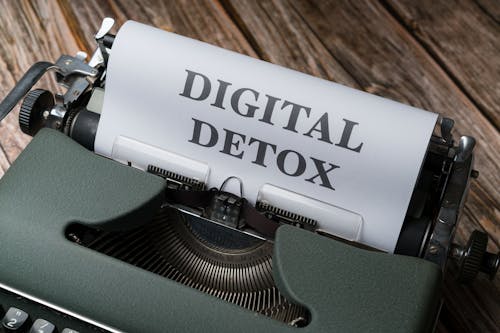
Introduction
In today’s fast-paced digital world, the constant presence of screens has become an integral part of our daily lives. From smartphones and laptops to tablets and smart TVs, technology is pervasive. While it offers numerous benefits, excessive screen time can negatively impact our mental and physical well-being. A digital detox can help restore balance, improve overall health, and enhance personal relationships. This comprehensive guide explores the benefits of a digital detox and provides practical steps to get started.
1. Understanding Digital Detox
Definition and Importance
A digital detox involves taking a break from digital devices to reduce stress, increase mindfulness, and reconnect with the physical world. It’s a conscious effort to limit screen time, allowing for mental and emotional recharge.
Signs You Need a Digital Detox
- Feeling overwhelmed or anxious when away from your device.
- Constantly checking notifications and social media.
- Difficulty concentrating on tasks without digital interruptions.
- Neglecting real-life relationships in favor of virtual interactions.
- Experiencing eye strain, headaches, or sleep disturbances.
2. Benefits of Digital Detox
Improved Mental Health
Reduced Stress and Anxiety
Constant connectivity can lead to information overload and increased stress. A digital detox helps to:
- Lower cortisol levels, reducing stress and anxiety.
- Provide mental clarity by minimizing distractions.
- Enhance mood by reducing exposure to negative online content.
Enhanced Focus and Productivity
Reducing screen time can significantly improve concentration and efficiency. Benefits include:
- Better focus on tasks without digital interruptions.
- Increased productivity due to fewer distractions.
- Enhanced creativity as the mind is free to wander without constant digital input.
Better Sleep Quality
Exposure to blue light from screens interferes with the production of melatonin, the sleep hormone. Benefits of reducing screen time before bed include:
- Improved sleep quality and duration.
- Easier time falling asleep.
- More restful and restorative sleep.
Physical Health Benefits
Reduced Eye Strain
Excessive screen time can cause digital eye strain, leading to discomfort and vision problems. A digital detox can:
- Alleviate symptoms such as dry eyes, headaches, and blurred vision.
- Promote eye health by reducing prolonged screen exposure.
Decreased Risk of Tech-Related Physical Issues
Spending too much time on digital devices can lead to physical ailments like neck pain, back pain, and repetitive strain injuries. Benefits include:
- Improved posture and reduced musculoskeletal discomfort.
- Increased physical activity as you engage in more offline activities.
Enhanced Relationships
Strengthened Personal Connections
Constant digital engagement can detract from face-to-face interactions. A digital detox helps to:
- Improve communication and intimacy in relationships.
- Foster deeper connections with family and friends.
- Increase presence and attentiveness during interactions.
More Meaningful Social Interactions
Engaging in offline activities encourages more meaningful and fulfilling social interactions. Benefits include:
- Developing new friendships and strengthening existing ones.
- Participating in group activities that promote bonding and camaraderie.
Increased Mindfulness and Presence
Enhanced Mindfulness
Taking a break from digital devices allows for greater mindfulness, helping you to:
- Be more present in the moment.
- Appreciate your surroundings and experiences.
- Develop a deeper sense of self-awareness.
Improved Emotional Well-being
Reduced digital engagement can lead to better emotional health by:
- Lowering the risk of digital addiction and dependency.
- Reducing exposure to negative online behaviors such as cyberbullying and comparison.
- Promoting a positive and balanced outlook on life.
3. How to Get Started with a Digital Detox
Set Clear Goals and Intentions
Identify Your Motivations
Determine why you want to undertake a digital detox. Common motivations include reducing stress, improving relationships, or enhancing productivity. Write down your reasons to stay motivated.
Define Your Detox Parameters
Decide on the specifics of your detox. Will you completely disconnect from all digital devices, or will you limit specific activities like social media or screen time after a certain hour? Setting clear parameters helps create a manageable and effective detox plan.
Create a Plan
Choose a Time Frame
Select a duration for your digital detox. It could be a weekend, a week, or even a month. Starting with a shorter period can make the detox more achievable and less daunting.
Communicate Your Plan
Inform family, friends, and colleagues about your digital detox. This ensures they understand your temporary unavailability and can provide support and accountability.
Set Boundaries and Rules
Establish No-Screen Zones
Designate certain areas of your home as no-screen zones, such as the bedroom, dining room, or living room. This encourages offline activities and interactions in these spaces.
Implement No-Screen Times
Set specific times of day when you will avoid using digital devices. Common no-screen times include during meals, an hour before bed, and immediately upon waking.
Find Alternative Activities
Engage in Physical Activity
Physical exercise is a great way to fill the time previously spent on screens. Consider activities such as:
- Going for walks or runs.
- Joining a gym or fitness class.
- Practicing yoga or meditation.
Reconnect with Hobbies
Rediscover offline hobbies and interests. Activities like reading, painting, gardening, or playing a musical instrument can be fulfilling and relaxing.
Prioritize Face-to-Face Interactions
Make an effort to spend more time with loved ones in person. Plan social activities such as:
- Family game nights or movie nights.
- Picnics, hikes, or outdoor adventures.
- Coffee dates or dinner gatherings with friends.
Use Technology Mindfully
Limit Social Media Use
If completely disconnecting from social media is challenging, try limiting your use. Set specific times for checking social media and stick to them. Consider using apps that track and limit your screen time.
Unsubscribe and Unfollow
Reduce digital clutter by unsubscribing from unnecessary email lists and unfollowing accounts that don’t add value to your life. This reduces the temptation to check your device frequently.
Digital Declutter
Organize your digital space by deleting unused apps, organizing files, and cleaning up your email inbox. A tidy digital environment can reduce stress and improve focus.
Practice Digital Mindfulness
Be Intentional with Screen Time
Use digital devices with a purpose rather than mindlessly. Before reaching for your phone or laptop, ask yourself if it’s necessary or if there’s an offline alternative.
Take Regular Breaks
Incorporate regular breaks from screens throughout your day. The 20-20-20 rule is a helpful guideline: every 20 minutes, take a 20-second break to look at something 20 feet away.
Reflect and Adjust
Evaluate Your Experience
After completing your digital detox, reflect on the experience. Consider the following questions:
- How did you feel without constant digital engagement?
- What changes did you notice in your mental and physical health?
- Did your relationships improve?
Adjust Your Habits
Based on your reflections, adjust your digital habits moving forward. Incorporate the strategies that worked well during your detox into your daily routine to maintain a healthier balance with technology.

Conclusion
A digital detox offers numerous benefits, including improved mental and physical health, enhanced relationships, and increased mindfulness. By setting clear goals, creating a plan, and finding alternative activities, you can successfully reduce your screen time and reconnect with the world around you. Start small, stay committed, and enjoy the positive changes that come from a balanced, mindful approach to technology use.









